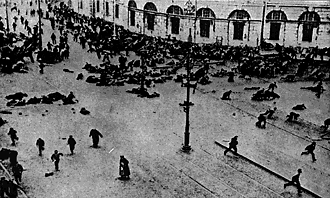Russian Revolution: The Civil War of 1918-1920

The Civil War of 1918-20
 Casualties of Bolshevik/Anti-Bolshevik violence Related Links |
The civil war between the Bolsheviks (Reds) and the anti-Bolsheviks (Whites) ravaged Russia until 1920. The Whites represented all shades of anti-Communist groups, including members of the constituent assembly. Several of their leaders favored setting up a military dictatorship, but few were outspoken czarists.
Armed opposition to the Soviet regime centered at first in the south, where the volunteers under Kornilov (succeeded by Denikin) joined forces with the Don Cossacks. The Ukraine was the scene of fighting after the Germans evacuated it following the general armistice of Nov. 11, 1918; it was seized by the Bolsheviks (early 1919), by Denikin's forces (Aug.-Dec., 1919), again by the Bolsheviks (Dec., 1919), and finally by the Poles (May, 1920), with whom war had broken out over the Russo-Polish frontier question. Denikin in the meantime had turned over his command to General P. N. Wrangel, who after the conclusion of the Russo-Polish armistice was driven by the Bolsheviks into the Crimea and was obliged to evacuate his forces to Constantinople (Nov., 1920).
The civil war in the east was equally fatal to the Whites. A government was organized at Samara by a group of Socialist Revolutionaries who had been members of the constituent assembly. It received the support of the Czech Legion, which controlled the Trans-Siberian RR, but it merged (Sept., 1918) with a more conservative government set up at Omsk, in Siberia, and a few weeks later fell under the dictatorship of Admiral Kolchak. Although at first successful, Kolchak's forces were eventually driven to the Russian Far East; by January, 1920, all Siberia except Vladivostok and some other Far Eastern territory was in Bolshevik hands.
The civil war was complicated by Allied intervention. In N Russia, British, French, and American forces occupied (March, 1918) Murmansk and later Archangelsk with the stated purpose of protecting Allied stores against possible seizure by the Germans; they were evacuated only in Nov., 1919. In the Russian Far East the Allies occupied Vladivostok, which the Japanese held until 1922.
The Bolshevik military victory was due partly to the lack of cooperation among the various White commanders and partly to the remarkable reorganization of the Red forces after Trotsky became commissar for war. It was won, however, only at the price of immense sacrifice; Russia by 1920 was ruined and devastated. Atrocities were committed throughout the civil war by both sides.
For the history of Russia after the civil war, see Union of Soviet Socialist Republics and Lenin, Vladimir Ilyich.
The Columbia Encyclopedia, Fifth Edition Copyright 1993, Columbia University Press. Licensed from Inso Corporation. All rights reserved.







